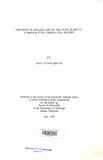| dc.description.abstract | This dissertation focuses on two major development actors in Africa as providers of
health care: the state versus civil society (non-state actors). Using the case of Kenya,
it examines the limitations of the state in the provision of health care, policy reforms
intended to improve the performance of the health sector, and civil society's role in
this process. More specifically, the dissertation focuses on the availability of, and
accessibility to, different types of state and non-state health facilities in Murang' a
district. Use of such facilities varies widely depending on a number of factors
examined in this dissertation.
The study is based on survey data of 504 women in Murang'a district. Using the
survey, the study simulates logistic regression models to estimate utilization of four
types of health facilities identified in the district and respondents' perception of user
fees. Additionally, secondary data from publications by the government of Kenya and
international organizations are used to supplement survey data.
This study has several findings related to policy reforms in Kenya's health sector.
For example, the study found that increasing public revenue for health through user
fees is not a panacea for Kenya's health crisis. Unless non-financial constraints are
first addressed, the potential of user fees will not be realized in Kenya.
Further, the study reveals that despite the controversial arguments on the net effects
of user fees, affordability of user fees is not a significant determinant of utilization of
public health facilities in Murang' a. Importantly, the introduction of user fees in the
district tends to significantly boost the utilization of mission hospitals. In general, the
findings of this study suggest that marginal charges at public health facilities are
unlikely to significantly reduce utilization of these facilities. Qualitative data suggest
that if efficiency and quality problems were first contained, the Kenyan state could
successfully boost its capabilities in the provision of health care by selectively
adopting a cost -sharing policy.
Last, during the advent of the user fees policy, the number of private clinics in
Murang'a has increased drastically. Their utilization now tends to surpass that of
corresponding government clinics. But in general, since non-state providers charge
relatively high prices for their services, non-state facilities should not be considered as
a substitute for public health facilities in Kenya. | en |

